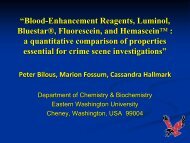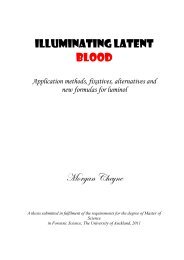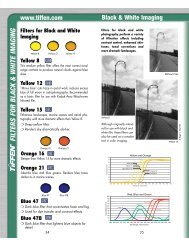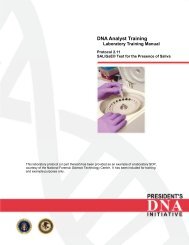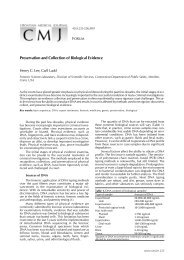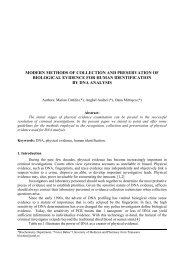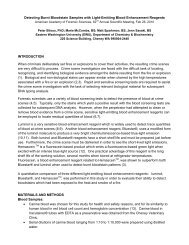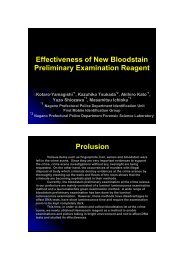HemaScein - Abacus Diagnostics, Inc.
HemaScein - Abacus Diagnostics, Inc.
HemaScein - Abacus Diagnostics, Inc.
You also want an ePaper? Increase the reach of your titles
YUMPU automatically turns print PDFs into web optimized ePapers that Google loves.
<strong>HemaScein</strong> TM<br />
Discovery and Testing for Human<br />
Blood<br />
by<br />
Larry Barksdale
<strong>HemaScein</strong> TM<br />
Purpose: Evaluate <strong>HemaScein</strong><br />
An easy to use kit for the presumptive discovery<br />
of human blood and the confirmation of human<br />
blood has long been needed for crime scene<br />
investigations. <strong>Abacus</strong> <strong>Diagnostics</strong> has<br />
developed the <strong>HemaScein</strong> TM kit to address<br />
this need.<br />
The purpose of this report is to present the<br />
results of the use of <strong>HemaScein</strong> TM by college<br />
students.
<strong>Abacus</strong> <strong>Diagnostics</strong><br />
<strong>HemaScein</strong> TM<br />
<strong>HemaScein</strong><br />
(http://www.abacusdiagnostics.com/hemascein.htm<br />
http://www.abacusdiagnostics.com/hemascein.htm)
HemaTrace Components:<br />
The Hematrace components<br />
consist of five Hematrace<br />
cassettes, swabs for collecting<br />
blood for testing, and swabs<br />
for collecting for DNA. A<br />
positive reaction is<br />
confirmatory for human<br />
blood.<br />
<strong>HemaScein</strong> TM<br />
Hemascein Components: To<br />
prepare add distilled water to the<br />
fluorescein formulation product vial<br />
and shake. Allow the vial contents<br />
to settle. Add distilled water to one<br />
of the ABA Spray containers. Draw<br />
off 2 ml of the vial contents liquid<br />
and add to the ABA sprayer. Fill the<br />
sprayer to 200 ml. Fill the other<br />
sprayer with 3 % hydrogen<br />
peroxide.
The Nature of the Problem<br />
The location of blood is a critical component of a crime<br />
scene investigation. In many cases the blood is readily<br />
visible to the unaided eye (patent stains). In other<br />
cases there is a need to enhance blood images (patent<br />
stains plus possible latent stains), and in the third case<br />
there is a need to discover blood not visible to the<br />
unaided eye (latent stains).<br />
Fluorescein, luminol, BLUESTAR®FORENSIC<br />
BLUESTAR FORENSIC and other<br />
products react with blood to produce a reaction that<br />
gives the appearance of emission of light. All are useful<br />
for the latent discovery of human blood, and for the<br />
presumptive identification of human blood.
The Crime Scene Investigator<br />
It is important to the crime scene investigator to<br />
have a process that is easy to store, easy to<br />
prepare, and easy to apply for the detection of<br />
latent bloodstains.<br />
It is important that the detection process can be<br />
readily documented through photography and<br />
visualization.<br />
It is important that the process presents minimal<br />
physical hazard to the crime scene investigator<br />
and any subsequent persons who might come in<br />
contact with any target area.
Literature Review: Positive<br />
Luminol<br />
Preparation is commercially<br />
available, only water is required to<br />
mix, no background staining,<br />
sensitivity on non-absorbent<br />
non absorbent<br />
surface at 1:100,000 and on<br />
absorbent surface at 1:100. 1<br />
It does not interfere with STR<br />
analysis of DNA. 2<br />
It produces an immediate bright<br />
reaction to undiluted blood, and a<br />
faster reaction to old blood .3<br />
BLUESTAR®FORENSIC<br />
BLUESTAR FORENSIC produced<br />
an immediate bright reaction. 4<br />
Features<br />
Fluorescein<br />
Preparation is commercially<br />
available and only water is needed<br />
to mix.<br />
It does not interfere with STR<br />
Analysis of DNA. 5<br />
It can be used in a less than<br />
complete dark environment, and<br />
the light emission is longer. 6<br />
The sensitivity is 2-5 2 5 times greater<br />
than luminol. Protein blood<br />
enhancement stains and dusting<br />
for fingerprints can be used after<br />
application. 7<br />
It has a low hazard to humans. 8<br />
It has a long shelf life. 9<br />
Real time photography can be<br />
accomplished with digital imaging<br />
techniques. 10<br />
Class and individual characteristics<br />
are possible end products. 11
Literature Review: Negative<br />
Luminol<br />
The reaction must be<br />
observed in the dark, and<br />
there is a short reaction<br />
time. 12<br />
It poses a potential health<br />
hazard and a liability. 13<br />
It has a very short shelf life. 14<br />
Preparation time is long<br />
term. 15<br />
Photography is difficult to<br />
do. 16 Light emission time is<br />
very short.<br />
Impression detail can rarely<br />
be photographically<br />
captured. 17<br />
Features<br />
Fluorescein<br />
It requires an Alternate<br />
Light Source, and the<br />
application of hydrogen<br />
peroxide as a second<br />
sprayed component. 18<br />
Technique is critical, and<br />
background can be<br />
problematic. 19<br />
The immediate emitted<br />
light reaction is not as<br />
intense as luminol. 20
Literature Review: False Positives<br />
Luminol can react with cupric sulfate, ferric sulfate, and<br />
nickel chloride, but not with 5% bleach, saliva, nor<br />
potato, as examples. BLUESTAR®FORENSIC<br />
BLUESTAR FORENSIC can react<br />
with potato, tomato, red onion, kidney bean,<br />
horseradish, ascorbic acid, 5% bleach, cupric sulfate,<br />
ferric sulfate, and nickel chloride. 21 Fluorescein can<br />
react with potato, non-human non human blood, and some oils as<br />
examples. 22<br />
The products are presumptive only and some false<br />
positives are presumptive. A comprehensive and<br />
exclusive list on false positives warrants further<br />
research. See http://www.bluestar-<br />
forensic.com/gb/compare.php for additional information.
Method 1<br />
Nebraska Wesleyan University (NWU) Forensic Science Graduate<br />
students in an Advanced Bloodstain Pattern Analysis seminar were<br />
provided two <strong>HemaScein</strong> TM kits. They were given directions to<br />
prepare exemplars with human blood dilutions, commercial stage<br />
blood products, red food coloring, Clorox, and red poster paint.<br />
They were assigned to prepare the fluorescein product via the kit kit<br />
instructions, apply the fluorescin to their exemplars, and document document<br />
and observe the reactions on the exemplar. They were to test<br />
known whole blood using the HemaTrace components of the kit.<br />
The exemplars were pieces of white “sheetrock sheetrock” that had been used<br />
in bloodstain research involving fly artifacts. The exemplar came came<br />
to<br />
the students with old human blood and fly artifacts.
Whole human blood<br />
and dilutions up to<br />
1:1000<br />
Old<br />
human<br />
blood<br />
Clorox<br />
Stage<br />
blood<br />
A = artifact,<br />
B = blood, C<br />
= control<br />
Test # 1,<br />
NWU<br />
Red<br />
food<br />
coloring<br />
Red<br />
poster<br />
paint
Whole blood<br />
with dilutions<br />
Old human<br />
blood<br />
A SPEX Handscope, CSS setting (`450<br />
nm) was used to illuminate the exemplar.<br />
bleach<br />
Fly<br />
artifact<br />
potato<br />
Stage<br />
blood<br />
The digital image was taken with a FUJI S9100 digital<br />
camera, hand held, auto mode, orange barrier filter.<br />
1:1000 human<br />
blood<br />
Red food<br />
coloring<br />
Poster<br />
paint<br />
Test #1,<br />
NWU, Results
Clorox<br />
potato<br />
Test # 2,<br />
NWU
A SPEX Handscope, CSS setting<br />
(`450 nm) was used to illuminate<br />
the exemplar.<br />
potato<br />
1:1000<br />
The digital image was taken with a FUJI S9100 digital<br />
camera, hand held, auto mode, orange barrier filter.<br />
Test # 2,<br />
NWU, results
Test # 3,<br />
NWU
Test # 3,<br />
NWU,<br />
results<br />
A SPEX Handscope, CSS setting<br />
(`450 nm) was used to illuminate<br />
the exemplar.<br />
1:1000<br />
The digital image was taken with a FUJI<br />
S9100 digital camera, hand held, auto<br />
mode, orange barrier filter.
Method 2<br />
University of Nebraska – Lincoln (UNL) undergraduate<br />
forensic science students in a crime scene investigation<br />
class were provided a <strong>HemaScein</strong> TM . They were given<br />
directions to prepare exemplars with human blood<br />
dilutions, commercial stage blood products, red food<br />
coloring, Clorox, and red poster paint. They were to<br />
prepare the fluorescein product via the kit instructions,<br />
apply the fluorescin to their exemplars, and document<br />
and observe the reactions on the exemplar. They were<br />
also to prepare luminol from raw materials, and<br />
BLUESTAR®FORENSIC<br />
BLUESTAR FORENSIC from a commercial kit, and apply<br />
to the exemplars.
Method 2 Exemplars<br />
The exemplars were pieces of white “sheetrock sheetrock” that had<br />
been used in bloodstain research involving fly artifacts.<br />
The exemplar came to the students with old human<br />
blood and old fly artifacts.<br />
Dilutions were prepared from freshly drawn human<br />
blood. Additional test spots were several commercial<br />
synthetic blood, stage blood, red food coloring, red<br />
poster paint, Clorox, and potato.<br />
The students didn’t photograph the reactions.
University of Nebraska<br />
Exemplar
University of Nebraska Student<br />
Observations<br />
Hemascein took longer to react, but<br />
lasted longer.<br />
Luminol reacted very fast.<br />
BLUESTAR®FORENSIC<br />
BLUESTAR FORENSIC reacted fastest,<br />
and was brighter than stock luminol and<br />
lasted a little longer than stock luminol.<br />
Hemascein lasted longest of the three.<br />
All three reacted up to 1:1,000,000.
Method 3<br />
Nebraska Wesleyan University students were<br />
asked to test the components of the<br />
<strong>HemaScein</strong> TM kit to test for human blood.<br />
They were charged with reading the kit<br />
instructions, following the instructions, and<br />
performing a confirmatory test.<br />
University of Nebraska students were charged<br />
with the same process, but they were to test a<br />
known fly artifact.
Method 3 Observations<br />
Nebraska Wesleyan University students reported<br />
positive results with swabs from the known, old,<br />
human blood using HemaTrace. Several<br />
students commented that the instructions should<br />
be written in more clear language.<br />
Four University of Nebraska student groups got<br />
positive results with known, old, fly artifacts.<br />
One group got negative results. This was using<br />
HemaTrace for confirmation of human blood.
Hemascein: Findings and<br />
Observations<br />
Students at both universities were able to follow the kit instructions instructions<br />
and<br />
successfully apply the Hemascein. Positive results were observed observed<br />
at<br />
1:1,000 (highest level tested) for human blood (NWU), and the 1:1,000,000<br />
1: 1,000,000<br />
(highest level tested) for human blood (UNL).<br />
Hemascein took some time to react. Once it reacted the emitted light<br />
presented for sufficient time to take real time digital images using using<br />
the Fuji<br />
digital camera auto setting in a hand held mode. Students noted that they<br />
had to spray the surface several times with Hemascein. This was a<br />
confirmation of the ability of the sprayers to prevent over spraying spraying<br />
of<br />
Hemascein.<br />
The fluorescein reaction never totally took place with all aspects aspects<br />
of the<br />
known whole human blood.<br />
Hemascein clearly worked best in the student exercises with more dilute<br />
bloodstains.
Findings and Observations:<br />
HemaTrace<br />
Students at both universities reported some<br />
difficulty in following the instructions for<br />
confirmatory testing using HemaTrace.<br />
They were eventually able to follow the<br />
instructions and to successfully complete the<br />
test.<br />
One test on fly artifacts was negative. This was<br />
using HemaTrace. 23<br />
<strong>HemaScein</strong> TM<br />
The availability of HemaTrace in <strong>HemaScein</strong><br />
was considered a positive feature of<br />
<strong>HemaScein</strong> TM .
Conclusion<br />
Fluorescin solution as presented in the form of Hemascein is viable viable<br />
for<br />
detecting human blood dilutions. Hemascein reacted with potato for a false<br />
positive. It didn’t didn t seem to react with synthetic blood, stage blood, food<br />
coloring, poster paint or bleach.<br />
Once the Hemascein reaction took place it lasted sufficient time for real<br />
time digital imaging without long term camera exposure.<br />
The HemaTrace tests worked as designed on known human blood when<br />
instructions were followed as written. This allows on scene positive positive<br />
identification of human blood.<br />
<strong>HemaScein</strong> TM<br />
<strong>HemaScein</strong>TM<br />
is a positive one stop kit for the discovery of latent blood<br />
and the confirmatory testing of blood.<br />
All tests (fluorescein products and luminol products) are only presumptive<br />
presumptive<br />
catalytic (peroxidase/reduction) reactions. They are subject to similar false<br />
positives variables like concentration and substrate background.
Conclusion (cont.)<br />
Current literature does not indicate destruction of DNA with<br />
application of fluorescin nor the amounts of hydrogen peroxide<br />
needed for the fluorescein reaction. The Hemascein formulation<br />
should present no threat to recovery of DNA.<br />
<strong>HemaScein</strong> TM addresses the issue of health hazards and liability with<br />
the fluorescein product as the primary blood detection product.<br />
The fine spray should reduce aesthetic and clean-up clean up issues when<br />
spraying the interior of vehicles.<br />
<strong>HemaScein</strong> TM sprayers worked as designed. In some cases students<br />
had to spray several times to get a reaction started. The sprayers sprayers<br />
effectively addressed the issues of over spraying of fluorescin<br />
solutions causing running of the bloodstains and over spraying of of<br />
fluorescin solutions causing background interference.
Epilogue: Author’s Author s Observations<br />
Fluorescein discovery and presumptive testing has an experiential experiential<br />
application curve.<br />
For those used to using luminol and luminol based products the immediacy immediacy<br />
and light<br />
intensity associated with fluorescein is not as great. It takes some getting used to<br />
knowing what you should see. Once you become accustomed to what to look for,<br />
fluorescein becomes a workable product for discovery of latent blood either<br />
singularly or as an extension of patent stains.<br />
Fluorescin does not react quickly with whole blood. This is a positive positive<br />
aspect for crime<br />
scene investigators. That is, if it is observable why test for latent materials? If there<br />
is a need for enhancement, use one of the protein stains. Fluorescein Fluorescein<br />
and luminol<br />
products are for what you cannot see. (Fluorescein is the material material<br />
added to make the<br />
solution. Fluorescin is the material in solution. Fluorescin goes goes<br />
back to fluorescein<br />
when reacting with blood components).<br />
Real time or very short time exposures are possible with fluorescein. fluorescein.<br />
This is due to<br />
the long reaction time and the use of the alternate light source. source.<br />
Photography has<br />
always been an issue with luminol and similar products due to the the<br />
need for long time<br />
exposures and continuous application to sustain the light emission. emission.<br />
The constant<br />
needed to apply luminol products often causes running of the latent blood blood<br />
materials<br />
and loss of detail. Heamscein offers a distinct advantage for capturing capturing<br />
image detail<br />
by lessening the problem of overspray and maintaining a long lasting lasting<br />
light emission.
Epilogue 3: Author Observations<br />
Application of fluorescein has always been an issue. Due to the longer reaction time,<br />
crime scene investigators seem to want to overspray. This can be a definite problem.<br />
<strong>Abacus</strong> has developed a superior sprayer. It is such that some students thought the<br />
sprayer was not working. The <strong>Abacus</strong> sprayer puts out a very fine low volume mist.<br />
This is a positive feature. Crime scene investigators not experienced with a<br />
fluorescein product will need to get used to using a finely engineered sprayer. It will<br />
keep them from over spraying, but they might have to make several applications.<br />
The sprayer for the hydrogen peroxide is a fine mist sprayer. This is a positive<br />
feature. It will prevent the historical issue of over spraying of the fluorescin.<br />
The <strong>Abacus</strong> sprayer should work very well for small areas. A motor vehicle interior,<br />
footwear, clothing, weapons, and similar targets should be the featured target for the<br />
<strong>Abacus</strong> sprayer. For large areas such as a living room of a house or a large carpet<br />
area, a larger volume sprayer would be needed for ease of application and timely<br />
results. The author most often uses a sprayer similar to a household cleaning<br />
product hand squeeze sprayer.<br />
Fluorescein works on Cold Cases. 24
Epilogue 4: Author Observations<br />
The liability issue has loomed large in the authors experience. A luminol application<br />
created substantial liability issue in a claim to purchase a vehicle and the payment of<br />
medical bills of an adult and children who were affected by the residue luminol left<br />
behind in the application to a vehicle interior. The author is aware of similar<br />
experiences by other law enforcement agencies. Hemascein does not present this<br />
liability issue of a residual hazardous material left behind at the scene.<br />
The search for a product to replace luminol, based on the health hazard issues, is<br />
what lead to the authors discovery of luminol as a possible product. This came about<br />
through the published research of Rob Cheeseman and his training programs. Since<br />
the late 90’s there has been a need to take fluorescein based products to the next<br />
level. Particularly to the level of addressing the issues of background and over<br />
spraying the solution. See www.rcforensic.com for additional information.<br />
<strong>Abacus</strong> <strong>HemaScein</strong> TM is a solution, solution in the author’s opinion, that meets the need for a<br />
better application of fluorescein products. Hemascein is the fluorescein based<br />
product in <strong>HemaScein</strong> TM . The inclusion of the Hematrace test is an added feature that<br />
should take question out of the issue of human blood. <strong>HemaScein</strong> TM as an example,<br />
could be the standard for bloodstain pattern analysis in terms of discovery and<br />
confirmation of human blood.
Epilogue 5: Author Observations<br />
See<br />
http://www.abacusdiagnostics.com/hemas<br />
cein.htm for detailed information<br />
Hemascein.<br />
See http://www.bluestarforensic.com/gb/compare.php<br />
for the<br />
PowerPoint of Jason Guffey on luminol,<br />
bluestar, and fluorescein. This site also<br />
provides information on on false positives.
End Notes<br />
1. Bruce Budowle, PhD., et.al. “The The Presumptive Reagent<br />
Fluorescein for Detection of Dilute Bloodstains and Subsequent STR STR<br />
Typing of Recovered DNA.” DNA. J Forensic Sci. Sci.<br />
2000; 45(5), p. 1091.<br />
2. Cathy J. Jakovich. “STR STR Analysis Following Latent Blood<br />
Detection by Luminol, Fluorescein, and BlueStar.” BlueStar. J Forensic Ident. Ident.<br />
2007; 57(2), PP. 196-197. 196 197. Budowle, et. al. reports similar results<br />
with luminol and fluorescein.<br />
3. Barksdale, L. Personal Experience. This is based on personal<br />
observations by the author during teaching exercises with college college<br />
students and in-service in service crime scene investigators. This has taken<br />
place over the past 30 years. Seven year old blood on a brown<br />
shag carpet, as an example, produced a bright blue luminol reaction reaction<br />
within one minute. Fluorescin took over 1 hour to produce the<br />
greenish-yellow greenish yellow glow associated with fluorescein.<br />
4. Tina Young. “Comparison Comparison of Luminol, Fluorescein, and Bluestar.” Bluestar.<br />
J. Forensic Ident. 2006; 56(60: p. 91.<br />
5. Ibid., 196-197, 196 197, STR Analysis Following Latent Blood Detection…<br />
Detection
End Notes (cont.)<br />
6. Ibid., 1090, The Presumptive Reagent Fluorescein for Detection of Dilute<br />
Bloodstains …<br />
7. Cheeseman, R. “Direct Sensitivity Comparison of the Fluorescein and Luminol<br />
Bloodstain Enhancement Techniques.” J Forensic Ident 1999; 49(3): 261-268.<br />
8-11. Ibid. Personal Experience. The author over the past 11 years in using<br />
fluorescein has never received a complaint from a citizen or investigator of direct<br />
health issues. Luminol and luminol based products are well known to cause high<br />
level health risks. The author has used a five year old fluorescin preparation. It is<br />
not uncommon to use a 1-2 month preparation. Luminol rarely last more than 1 hour.<br />
All preparations, including fresh preparations, should be tested on a known exemplar<br />
prior to scene application. The long lasting fluorescence from fluorescein and the<br />
alternate light source intensity combine to allow immediate digital imagining of<br />
fluorescein reactions. Thus, additional materials not required to maintain a reaction<br />
as it is in the case of luminol. This allow a higher probability of detail with fluorescein<br />
reactions. The author has captured numerous shoe wear impressions that provided<br />
class characteristic comparison.
End Notes (cont.)<br />
12. Ibid., idem, 1090-1091, 1090 1091, The Presumptive Reagent Fluorescein for Detection of<br />
Dilute Bloodstains …<br />
13. Ibid., Personal Experience. The author has been involved in several cases in<br />
which investigators reported burning to their hands and face after after<br />
using luminol.<br />
Two cases have been adjudicated in which private citizens filed a claim and received<br />
compensation directly due to health issues arising from the use of luminol. The white<br />
residue left by luminol can cause burning, redness, and rash if contacted by human<br />
skin. In both cases the jurisdiction of record bought motor vehicles vehicles<br />
that had been<br />
processed with luminol.<br />
14. Ibid., idem, The author has conducted personal research using using<br />
bloodstain<br />
footwear impressions on white linoleum and on concrete. Luminol provided a nearly<br />
useless reaction 30 minutes after preparation. Fluorescin can still still<br />
be effective years<br />
after preparation.<br />
15. Ibid., idem, Luminol preparation from raw chemicals typically typically<br />
takes about one<br />
hour to go into solution. Commercially prepared products are much much<br />
faster.
End Notes (cont.)<br />
16-17. 16 17. A typical luminol photographic technique is a 15 – 30 second shutter speed<br />
with an f 2.0 aperture. It is usually necessary to keep refreshing refreshing<br />
the target with<br />
luminol. This increases the probability for loss of image detail. detail.<br />
18. Ibid., idem, 1090-1091, 1090 1091, The Presumptive Reagent Fluorescein for Detection of<br />
Dilute Bloodstains …<br />
19-20. 19 20. Ibid., idem, Personal Experience. The author has noted a tendency tendency<br />
for<br />
investigators to overspray. Fluorescein requires spraying above the target, as an<br />
example, and allowing the product to drift onto the target. Old blood can take up to<br />
one hour to react. Fresh and diluted blood typically reacts in less than one minute.<br />
The slower reaction time for those used to using luminol seems to to<br />
spur a need for<br />
repeated spraying in the anticipation of a reaction. The yellowish yellowish-green<br />
green fluorescein<br />
reaction is not as intense and aesthetic as that of luminol. This This<br />
causes some<br />
investigators to feel the fluorescein is not working and to apply apply<br />
more material. There<br />
is a learning and experience curve associated with fluorescein recognition. recognition.<br />
This<br />
seems to be particularly so for those used to using luminol. Fluorescein Fluorescein<br />
has a<br />
tendency to produce background fluorescence. This can particularly particularly<br />
be a problem<br />
with over spraying.
End Notes (cont.)<br />
21. Tobe SS, Watson N, Daeid NN. “Evaluation Evaluation of Six Presumptive Tests for Blood, Their<br />
Specificity, Sensitivity, and Effect on High Molecular-Weight Molecular Weight DNA.” DNA. J Forensic Sci 2007; 52(1):<br />
106.<br />
22. Ibid., idem, Personal Experience. The author has observed fluorescein reactions with potato,<br />
bovine blood, and motor vehicle oil. Luminol will react violently violently<br />
with Clorox. The author often<br />
uses Clorox as a “gee gee whiz” whiz demonstration with students. Luminol and fluorescein will react with<br />
rust from lawn furniture left on concrete. Fluorescein, Luminol, Luminol,<br />
and Bluestar will react with fly<br />
spots, cockroach stains, and bug splatters (not spatters) on a car car<br />
windshield. See www.bluestar-<br />
forensics.com for information on false positives.<br />
23. The instructor observed that several of the reactions from the fly artifacts were rather slow.<br />
Several students initially reported a negative and left their test. test.<br />
After walking around to look at<br />
other students results they came back and noticed theirs had a weak weak<br />
reaction. It may be that the<br />
one groups did not properly follow instructions, or they may have have<br />
given up on their test. Further<br />
research is in order with fly artifacts and HemaTrace.<br />
24. A piece of red clothing had been processed by a state forensic forensic<br />
lab and a federal forensic lab.<br />
Both labs reported no presence of blood on the clothing. The clothing clothing<br />
was taken from storage<br />
after about ten years from the time of the original examination and examined with the application<br />
of fluorescin. There was a reaction area. This area was swabbed swabbed<br />
and sent for DNA analysis. A<br />
full DNA profile was gotten from this swab.
References<br />
Barksdale, LE. “Observations Observations of reactions times luminol and<br />
fluorescein on bloodstains.” bloodstains. Personal Experience. 1977 - 2009.<br />
Budowle B, Leggitt JL, Defenbaugh DA, Keys KM, Malkiewicz SF.<br />
“The The Presumptive reagent fluorescein for detection of dilute<br />
bloodstains and subsequent SSTR typing of recovered DNA. J<br />
Forensic Sci 2000; 45(5): 1090-1092.<br />
1090 1092.<br />
Cheeseman R, DiMeo LA. “Fluorescein Fluorescein as a field worthy latent<br />
bloodstain detection system.” system. J Forensic Ident 1995; 45(6):<br />
631-646. 631 646.<br />
Cheeseman, R. “Direct Direct sensitivity comparison of the fluorescein and<br />
luminol bloodstain enhancement techniques.” techniques. J Forensic Ident<br />
1999; 49(3): 261-268. 261 268.<br />
Gardner, R. Practical Crime Scene Processing and Investigation.<br />
Investigation.<br />
Boca Raton: CRC Press, 2005.
References (cont.)<br />
Jakovich CJ, “STR STR Analysis Following Latent Blood<br />
Detection by Luminol, Fluorescein, and Bluster.” Bluster. J<br />
Forensic Indent 2007; 57(2): 193-198. 193 198.<br />
Tobe, SS, Watson, N, Daeid, NN. “Evaluation Evaluation of Six<br />
Presumptive Tests for Blood, Their Specificity,<br />
Sensitivity, and Effect on High Molecular-Weight<br />
Molecular Weight<br />
DNA.” DNA. J Forensic Sci 2007; 52(1): 102-109. 102 109.<br />
Young, T. “A A Photographic Comparison of Luminol,<br />
Fluorescein, and Bluestar.” Bluestar. J Forensic Ident<br />
2006; 56(6): 906-912. 906 912.



